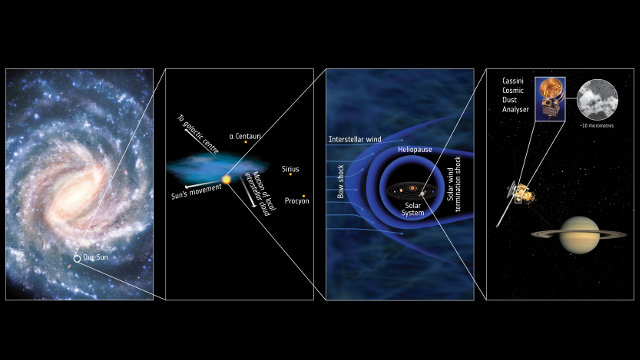
An article published in the journal “Science” describes the analysis of the composition of interstellar dust that entered the solar system and was intercepted by the Cassini space probe. Among the instruments on board there’s the Cosmic Dust Analyser (CDA), which over the years of its mission has collected millions of dust samples: 36 of them were found to be of interstellar origin.
It’s not the first time that dust arrived from outside the solar system is intercepted by a spacecraft because already in the ’90s Ulysses found it and later Galileo confirmed the discovery. This dust comes from the local interstellar cloud, a bubble of gas and dust the solar system is passing through. Those clues allowed to make a specific search among the data collected by Cassini on the dust analyzed since 2004.
Interstellar dust has well-defined direction and speed, in fact, the small grains captured by Cassini were traveling at over 72,000 km/h (about 45,000 mph) and their direction was also different from the common icy dust generally captured in the area around the planet Saturn. Compared to previous space probes, Cassini is equipped with the CDA instrument that could analyze these grains.
Nicolas Altobelli, ESA Cassini mission scientist and lead author of the study, and his colleagues expected to find a variety in the composition of the interstellar dust grains because they thought that they had different origins, created by various exploding stars at different times that ejected in space different elements. Instead, the grains have a very similar chemical composition, especially magnesium, calcium, iron, silicon and oxygen, present in proportions in the average for that type of dust. Elements such as sulfur and carbon are present lower than the average amounts.
It’s possible that dust grains in a star-forming region might be destroyed and then re-condense a number of times when they are pushed by the shock waves of dying stars to other systems. Grains transformed in that way may have been pushed into our solar system.
It’s a hypothesis and the study conducted thanks to the Cassini space probe allowed to gain new information that can help to get an answer. So far, an analysis of interstellar dust was made on particles collected by the Stardust spacecraft so the 36 grains collected by Cassini are a little big treasure.
This kind of research may seem of little importance but interstellar dust particles are the product of ancient supernovae and after even a few billion years can become part of a new solar system. In essence, these few tiny grains can give us new information on the formation processes of stars and planets. It’s for this reason that researchers consider these analyzes ambitious goals.

